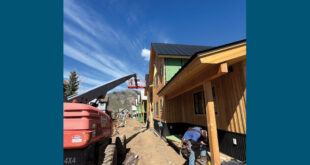Presents study’s findings to property owners
It isn’t cheap to live in paradise, but is it worth the cost of incorporation? That’s what a report discussed at the Crested Butte South Property Owner’s Association (POA) annual meeting August 10 is meant to help residents answer.
{mosloadposition user 1}
“The goal [of the report] was to inform people of the financial feasibility of incorporation, so we weren’t looking for feedback [at the meeting] as much as we were trying to inform,” says Chris Behan, manager of the Crested Butte South Property Owner’s Association.
The report details the costs of three possible scenarios for the subdivision, which is currently unincorporated and operates on dues paid by its homeowners.
The county is currently considering designating Crested Butte South as a special area, which would grant the subdivision authority over certain internal operations, such as the enforcement of building codes.
All three scenarios considered in the report include incorporation, but change the relationship between the POA and the Crested Butte South Metropolitan District, which are now run as separate entities.
The first scenario incorporates the subdivision but leaves the POA and the Metropolitan District separate, while the second scenario would bring only the POA into the incorporated town. The last option offered in the report brings the subdivision, the POA and the Metropolitan District into an incorporated town.
During the annual meeting “Incorporation was presented as the preferred alternative,” says Behan, adding that there is a lot of preparation and property owner education that will be required of the POA before incorporation ever becomes an option.
However, the special area designation is largely recognized as being the first step in that process. Even if the county grants the designation, Behan knows the subdivision is a long way from incorporation.
In order for Crested Butte South to incorporate, a measure would have to be included on the ballot and passed by a simple majority of all county voters in a November election.
“It will take much more time to see if there are enough of those people [who support the idea] to pursue incorporation on the ballot,” he says. “I think it would be super ambitious to say that it would be on the ballot in 2010.”
If the measure passes, the newly formed government would decide what taxes to levy, such as sales and property taxes. That would be voted on by the town’s residents in November of the next odd-numbered election year.
According to Behan, the dues that property owners now pay to the POA would be incorporated into the total tax on a property. One mil is equal to $1 of taxes paid for each $1,000 of a property’s assessed value.
In 2008, the budget for an unincorporated Crested Butte South was just over $217,000 and, according to the report, if incorporation were to occur the budget would need to be between $750,000 and $1.2 million, depending on the scenario.
Currently, dues for property owners are arranged in three set tiers: $111.45 paid annually for vacant lots, $222.81 paid annually for residential lots, and $459.64 for commercial lots.
In addition to what property owners currently pay in taxes, Behan says at least five mils would be added on to cover the costs of running the town.
By becoming a town, Crested Butte South would take on many of the costs now handled by the county, like maintaining government buildings and infrastructure as well as taking on the cost of maintaining a staff.
According to the report, the objective for an incorporated Crested Butte South would be to “create a modern, full-service community but not a full-service government,” meaning that the existing inter-governmental agreements (IGA) for fire and police protection would continue, eliminating the need for additional layers of government to provide those services.
“We wouldn’t have our own police, or our own fire or water and sewer. The Metro District and the IGAs that cover emergency services would stay and that would eliminate a lot of additional cost,” says Behan.
By saving the cost of incorporation through those types of “efficiencies,” the town would have more money for the amenities.
“We can’t pave the rest of the sidewalk because we need another $60,000. But as a municipality we would have the opportunity to have more and different income streams to pay for that kind of stuff,” Behan said.
One of those income streams is sales tax, which Behan says could offset the mil levy increase that would be needed to start the town and possibly even eliminate it, if more businesses could be attracted into the area. Last year, there were $3 million in transactions in Crested Butte South, which a municipality could tax.
Currently, Gunnison County collects 1 percent in sales tax with an additional 2.99 percent going to the state. No revenue is dedicated to Crested Butte South itself.
In addition, if Crested Butte South were to incorporate, it could supplement its income with grants, fees on licenses, permits, franchises and other things.
“What I think it boils down to is income opportunities and the way things are set up. By incorporating, we’ll be able to collect income tax and property tax and we’ll be able to go after some of the government grant monies that people are not going to get themselves,” says Behan.
The next step toward the incorporation of Crested Butte South is a special area designation, which will be decided by the County Commissioners at their regular meeting on September 2.
 The Crested Butte News Serving the Gunnison Valley since 1999
The Crested Butte News Serving the Gunnison Valley since 1999

